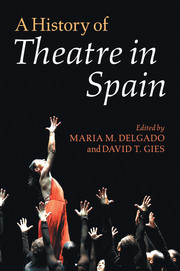Book contents
- Frontmatter
- Contents
- Illustrations
- Contributors
- Acknowledgements
- Introduction
- 1 The challenges of historiography
- 2 Lope de Vega, Calderón de la Barca and Tirso de Molina
- 3 The world as a stage
- 4 Playing the palace
- 5 The art of the actor, 1565–1833
- 6 Theatrical infrastructures, dramatic production and performance, 1700–1759
- 7 Popular theatre and the Spanish stage, 1737–1798
- 8 Theatre of the elites, neoclassicism and the Enlightenment, 1750–1808
- 9 Actors and agency in the modern era, 1801–2010
- 10 Zarzuela
- 11 Nineteenth-century Spanish theatre
- 12 Copyright, buildings, spaces and the nineteenth-century stage
- 13 Modernism and the avant-garde in fin-de-siècle Barcelona and Madrid
- 14 Continuity and innovation in Spanish theatre, 1900–1936
- 15 Theatrical activities during the Spanish Civil War, 1936–1939
- 16 Theatre, colonialism, exile and the Americas
- 17 Theatre under Franco (1939–1975)
- 18 Flamenco
- 19 Nationalism, identity and the theatre across the Spanish state in the democratic era, 1975–2010
- 20 Directors and the Spanish stage, 1823–2010
- 21 This evolution is still ongoing
- 22 Theatre as a process of discovery
- 23 Theatre is the art of the future
- Select bibliography
- Index
- References
5 - The art of the actor, 1565–1833
From moral suspicion to social institution
Published online by Cambridge University Press: 05 June 2012
- Frontmatter
- Contents
- Illustrations
- Contributors
- Acknowledgements
- Introduction
- 1 The challenges of historiography
- 2 Lope de Vega, Calderón de la Barca and Tirso de Molina
- 3 The world as a stage
- 4 Playing the palace
- 5 The art of the actor, 1565–1833
- 6 Theatrical infrastructures, dramatic production and performance, 1700–1759
- 7 Popular theatre and the Spanish stage, 1737–1798
- 8 Theatre of the elites, neoclassicism and the Enlightenment, 1750–1808
- 9 Actors and agency in the modern era, 1801–2010
- 10 Zarzuela
- 11 Nineteenth-century Spanish theatre
- 12 Copyright, buildings, spaces and the nineteenth-century stage
- 13 Modernism and the avant-garde in fin-de-siècle Barcelona and Madrid
- 14 Continuity and innovation in Spanish theatre, 1900–1936
- 15 Theatrical activities during the Spanish Civil War, 1936–1939
- 16 Theatre, colonialism, exile and the Americas
- 17 Theatre under Franco (1939–1975)
- 18 Flamenco
- 19 Nationalism, identity and the theatre across the Spanish state in the democratic era, 1975–2010
- 20 Directors and the Spanish stage, 1823–2010
- 21 This evolution is still ongoing
- 22 Theatre as a process of discovery
- 23 Theatre is the art of the future
- Select bibliography
- Index
- References
Summary
The cultural and commercial institutionalisation of Spanish theatre came about in the sixteenth century. The first patios (yards) date to around 1565; more such spaces, modelled after Madrid's successful corrales (courtyard playhouses), including the Corral de la Cruz (1579) and the Corral del Príncipe (1582), would eventually be built in order to satisfy the demand of a heterogeneous urban public, largely made up of the middle and popular classes, whose appetite for entertainment would give rise to the first theatre companies and professional playwrights. The process was part of the particular socioeconomic circumstances linking theatrical entertainment with religious–philanthropic enterprise; the cofradías (religious brotherhoods) and hospitals that administered establishments of public charity were also responsible for managing the theatre. The moral justification behind this commercialisation would make Spanish Golden Age theatre less vulnerable to the types of attacks suffered by contemporary English theatre under the Puritans. The cofradías gradually transferred the economic administration of the theatres to an individual (the arrendador) in charge of maintaining business relationships with those responsible for the production (the playwright, the autor or actor-manager of the company, the actors, doormen, carpenters – who were essential for maintaining the physical structure of the stage and its diverse machinery – the fruit sellers and alojeros [or sellers of the popular drink made from water, honey and spices known as aloja], and others). After 1638, the economic administration of the theatres was ceded to local authorities, who in turn yielded part of the profits back to the cofradías and hospitals. Spain's stable, commercial theatre, born under moral pretences, would eventually become politically controlled, falling under the supervision of an advisory body presided over by the Protector de los Teatros, whose authority was granted directly by the king.
- Type
- Chapter
- Information
- A History of Theatre in Spain , pp. 103 - 119Publisher: Cambridge University PressPrint publication year: 2012
References
- 1
- Cited by

